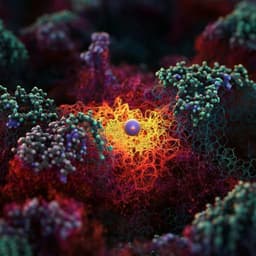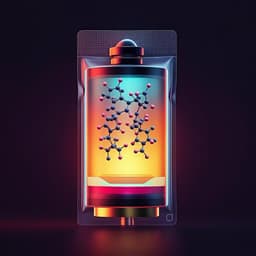
Engineering and Technology
A non-Newtonian fluid quasi-solid electrolyte designed for long life and high safety Li-O₂ batteries
G. Zheng, T. Yan, et al.
This groundbreaking research by Guangli Zheng and colleagues reveals a revolutionary non-Newtonian fluid quasi-solid electrolyte for Li-O₂ batteries, showcasing remarkable Li⁺ conductivity and an incredible lifespan of over 5000 hours!
~3 min • Beginner • English
Introduction
Commercial Li-ion batteries are approaching their theoretical energy density (e.g., C/LiCoO₂ ~387 Wh kg⁻¹) and face challenges meeting demands for large-scale energy storage and long-duration devices. Li–O₂ batteries are attractive for their ultra-high theoretical energy density (~3500 Wh kg⁻¹), but practical deployment is hindered by electrolyte leakage/volatilization inherent to semi-open architectures and poor cycling stability. Conventional porous separators (PP, glass fiber) are vulnerable to Li dendrite penetration, leading to short circuits and safety risks. Prior efforts to reduce electrolyte volatility (e.g., sulfamide/sulfonamide-based electrolytes, glyme solvate ionic liquids) alleviate but do not eliminate volatilization; ionic conductivity and cycle life deteriorate as electrolyte is consumed. This work targets a multifunctional electrolyte strategy to simultaneously prevent liquid electrolyte loss and suppress dendrite growth by leveraging non-Newtonian rheology—shear-thinning to absorb plating/stripping stress and accommodate Li volume change, and shear-thickening to stiffen under sudden load and resist dendrite penetration. The proposed NNFQSE uses sulfonated silica nanofillers (SiO₂-SO₃Li) within a PVDF-HFP matrix to form a honeycomb cross-linked network with strong component interactions, enhanced Li⁺ transport, and high liquid retention, enabling long-life, safer Li–O₂ batteries.
Literature Review
- Low-volatility electrolytes (e.g., sulfamide/sulfonamide-based and glyme solvate ionic liquids such as [Li(G3)][TFSA], [Li(G3)₄][TFSA]) have been explored to mitigate evaporation in Li–O₂ cells; however, they remain volatile to some extent, and performance degrades as electrolyte is consumed.
- Conventional porous separators (PP, GF) are susceptible to Li dendrite penetration during long cycling, risking internal shorting and thermal runaway.
- Non-Newtonian materials balance flexibility with impact protection (e.g., shock absorbers, body armor); their viscosity-shear rate relationship is nonlinear, enabling shear-thinning or thickening.
- Prior battery applications of non-Newtonian behavior include a shear-thinning, quicksand-like semi-solid Li metal anode (lithium powder/CNTs/PEO in electrolyte) that adapts to volume changes and relieves dendrite stress, and a dynamically interconvertible “solid–liquid” starch-based electrolyte for Zn batteries that shear-thickens to resist dendrite growth in fast-growing regions. These studies motivated adopting non-Newtonian rheology in multifunctional electrolytes for Li systems.
Methodology
Materials synthesis and electrolyte fabrication:
- SiO₂-SO₃Li nanoparticles: (1) Synthesize porous SiO₂ by mixing 2.0 g CPB and 1.2 g urea in 60 mL deionized water (solution A). Prepare solution B with 3 mL pentanol, 5.4 mL TEOS, 60 mL cyclohexane. Add B dropwise to A after A becomes transparent, stir 1 h, hydrothermal at 120 °C for 24 h in Teflon-lined autoclave. Filter, wash, dry (70 °C, vacuum, 6 h), then calcine at 600 °C for 5 h to remove surfactant. (2) Sulfonate by soaking SiO₂ in excess H₂SO₄ for 24 h, centrifuge, wash, vacuum dry at 70 °C to obtain SiO₂-SO₃H. (3) Neutralize with LiOH for 24 h, centrifuge, wash, dry to yield SiO₂-SO₃Li.
- PVDF-HFP-based membranes (tape casting): (i) PVDF-HFP: dissolve 0.25 g PVDF-HFP in 4.5 g acetone; add 0.25 g ethanol dropwise, stir 0.5 h, cast on Teflon mold, dry naturally, peel and vacuum dry at 60 °C. (ii) SiO₂/PVDF-HFP: dissolve 0.139 g PVDF-HFP in 4.5 g acetone (1 h), add 0.110 g SiO₂ nanoparticles, cast and dry as above. (iii) SiO₂-SO₃Li/PVDF-HFP: replace SiO₂ with 0.110 g SiO₂-SO₃Li; final membrane ~100 μm thick, 19 mm diameter. All membranes soaked in 1 M LiTFSI/TEGDME for 24 h in Ar glovebox; surface LE wiped to semi-dry transparent state.
- Electrodes: Li metal anode 0.6 mm thick, 16 mm diameter. Cathode: homemade hollow-fiber carbon material loaded with 3 wt% Ru (from 5 mg mL⁻¹ RuCl₃ solution, freeze-dried, reduced at 1000 °C in H₂ for 2 h), disk 6 mm diameter, ~1 mm thick, loading ~21.2 mg cm⁻².
Characterization and testing:
- Structural/chemical: SEM (Hitachi SU8220), TEM (JEOL JEM-2100HR), XRD (Bruker D8, Cu Kα, 40 kV/40 mA), XPS (Thermo ESCALAB Xi+, Al Kα), FTIR (Bruker Tensor 27, 4000–400 cm⁻¹), EDS mapping, ICP-MS for S and Li content, contact angle (Dataphysics OCA40 Micro), MIP porosimetry.
- Rheology: R/S rheometer (Brookfield), modulus oscillation mode 0.1–100 Hz; G′ and G″ vs frequency to assess shear-thinning/thickening behavior.
- NMR: ⁷Li, ¹H, ¹³C (Bruker 600 MHz) to probe interactions between fillers/polymer and LE (1 M LiTFSI/TEGDME).
- Electrochemistry: EIS (Metrohm Autolab PGSTAT30, 10⁶–0.1 Hz, 10 mV AC) to extract bulk resistance and calculate ionic conductivity; Arrhenius analysis for activation energy. LSV window from 2.5–6.0 V at 1 mV s⁻¹ (Li vs stainless steel). Cells assembled as CR2032 in Ar glovebox (O₂ < 0.01 ppm, H₂O < 0.01 ppm), tested on NEWARE (CT-4008) at room temperature.
- Electrolyte uptake and retention: EU=(W−W₀)/W₀×100% after saturation in LE; retention tracked by mass vs time in flowing air. Heat shrinkage: 180 °C, 1 h. Mechanical properties: nano-indentation before/after cycling; COMSOL Multiphysics simulations of membrane deformation and dendrite growth (membrane 19 mm diameter, 100 μm thick; center displacement increments 5 nm for 100 steps), Von Mises stress maps; dendrite growth under identical protrusion/current with and without NNFQSE over 300 s.
- Battery tests: Li|electrolyte|Li symmetric cells at specified current densities; Li–O₂ cells with limited capacity 600 mAh g⁻¹, galvanostatic cycling at 100 mA g⁻¹ and various rates.
Key Findings
- Morphology and structure: NNFQSE forms a honeycomb, cross-linked network via ion–dipole interactions between PVDF-HFP (-CFₓ) and SiO₂-SO₃Li sulfo groups. SiO₂-SO₃Li nanoparticles retain wrinkled radial morphology with deeper, richer surface channels than unmodified SiO₂, increasing total pore area and LE trapping. MIP: PVDF-HFP porosity 74.6%, volume density 0.34 g mL⁻¹; adding SiO₂ lowers porosity to 58.4% and raises density to 0.59 g mL⁻¹; SiO₂-SO₃Li/PVDF-HFP falls between them. Total pore area increases from 7.56 to 16.06 to 18.23 m² g⁻¹ (PVDF-HFP, SiO₂/PVDF-HFP, SiO₂-SO₃Li/PVDF-HFP). XRD shows reduced (110) intensity with SiO₂-SO₃Li, indicating lower crystallinity and enhanced polymer segmental motion.
- Wettability and retention: Contact angles (with 1 M LiTFSI/TEGDME): PVDF-HFP 103.0°, SiO₂/PVDF-HFP 102.9°, SiO₂-SO₃Li/PVDF-HFP 39.9°. Electrolyte uptake: 270 wt% (PVDF-HFP), 300 wt% (SiO₂/PVDF-HFP), 380 wt% (SiO₂-SO₃Li/PVDF-HFP). Retention in flowing air after 360 h: SiO₂-SO₃Li/PVDF-HFP 90.5%, superior to others. Heat shrinkage at 180 °C for 1 h: ~75% (PVDF-HFP), 61% (SiO₂/PVDF-HFP), ~1% (SiO₂-SO₃Li/PVDF-HFP); PP dissolves completely.
- Molecular interactions: ⁷Li-NMR resonance shifts from −1.017 ppm (LE) to −1.034 ppm (SiO₂-SO₃Li+LE) and −1.044 ppm (SiO₂-SO₃Li/PVDF-HFP+LE), evidencing interactions anchoring LiTFSI within nanofillers/polymer. ¹H and ¹³C NMR of TEGDME show shifts indicating solvent-filler/polymer interactions. FTIR/XPS confirm successful grafting of −SO₃Li on SiO₂ and ion–dipole interactions with PVDF-HFP.
- Rheology: G′ > G″ at low strain (solid-like), shear-thinning observed over 0.38–29.8 Hz (G″ > G′ as strain increases), and shear-thickening resumes at >29.8 Hz (G′ > G″), enabling stress absorption during Li plating/stripping and rapid stiffening under sudden load to resist dendrites.
- Ionic transport and stability: Ionic conductivity at 20 °C: SiO₂-SO₃Li/PVDF-HFP 5.4×10⁻3 S cm⁻1 (lowest impedance among compared membranes). Activation energy: 0.10 eV (SiO₂-SO₃Li/PVDF-HFP), vs 0.34 eV and 0.35 eV for controls. Electrochemical stability window up to 4.85 V (PVDF-HFP oxidizes at ~4.1 V; SiO₂/PVDF-HFP at ~4.5 V).
- Symmetric Li cells: At 0.5 mA cm⁻², SiO₂-SO₃Li/PVDF-HFP shows smallest polarization (~25 mV); this advantage persists using LiPF₆/EC-DEC instead of LiTFSI/TEGDME. At 1 mA cm⁻², stable cycling >2000 h with low polarization (~50 mV), indicating effective dendrite suppression.
- Li–O₂ cells: With capacity limited to 600 mAh g⁻¹ at 100 mA g⁻¹, NNFQSE-based cells operate stably for >5000 h at 25 °C, outperforming PP, PVDF-HFP, and SiO₂/PVDF-HFP. Good rate capability at 150, 200, 500, 1000 mA g⁻¹ with recovery upon rate return; controls show unstable rate performance. EIS shows lower total impedance and good interfacial contact; total impedance increases modestly from 91 Ω to 330 Ω after long cycling.
- Post-cycling stability: After 5000 h, NNFQSE remains moist and elastic jelly-like; PVDF-HFP and SiO₂/PVDF-HFP dry or break. Honeycomb channels and nanofiller structures persist (SEM/EDS). FTIR/XPS show no new peaks; F 1s indicates LiF formation (beneficial SEI), with shifts consistent with strong electron-withdrawing −SO₃H surroundings.
- Mechanics and simulations: Nano-indentation (after 200 h): hardness decreases from 93.19 to 49.6 MPa; elastic modulus from 2.27 to 1.02 GPa, evidencing shear-thinning/softening to absorb stress. COMSOL load–displacement shows reduced ultimate load after cycling; Von Mises stress lower post-cycling, indicating reduced puncture risk. Dendrite growth simulations (300 s): with NNFQSE, dendrite length grows from 3.5 to 3.9 μm (~11%); without NNFQSE to 7.8 μm (>100%), demonstrating mechanical suppression of dendrites under high local current/stress.
Discussion
The NNFQSE addresses Li–O₂ battery challenges by combining structural and rheological strategies. Ion–dipole interactions between PVDF-HFP and SiO₂-SO₃Li create a robust, honeycomb network that traps liquid electrolyte, enhancing wettability, uptake, and long-term retention to mitigate volatilization/leakage in semi-open cells. The sulfonated silica nanofillers provide additional Li⁺ binding/transport pathways, reducing activation energy and increasing ionic conductivity. Rheologically, the electrolyte shear-thins during steady Li plating/stripping, reducing mechanical stress and accommodating volume changes, as evidenced by decreased hardness/modulus and lower Von Mises stress after cycling. Under sudden, localized high current densities or uneven deposition, the material shear-thickens, rapidly stiffening to resist dendrite intrusion, consistent with the observed and simulated suppression of dendrite growth. Electrochemically, the NNFQSE enables stable symmetric Li cycling (>2000 h at 1 mA cm⁻², low polarization) and long-lived Li–O₂ operation (>5000 h at 100 mA g⁻¹ with 600 mAh g⁻¹ capacity limit), with a wide electrochemical window (to 4.85 V) and modest impedance growth, indicating interfacial stability. Formation of LiF within the SEI (indicated by XPS) further helps block electron leakage and discourages vertical dendrite growth. Collectively, these results validate the hypothesis that a non-Newtonian, component-interactive quasi-solid electrolyte can simultaneously enhance safety and longevity in Li–O₂ systems.
Conclusion
A multifunctional non-Newtonian fluid quasi-solid electrolyte (SiO₂-SO₃Li/PVDF-HFP) was developed that combines high liquid electrolyte retention, enhanced Li⁺ transport (5.4×10⁻3 S cm⁻1 at 20 °C; Eₐ ~0.10 eV), wide electrochemical stability (to 4.85 V), and thermal robustness (~1% shrinkage at 180 °C). Its shear-thinning behavior relieves stress during Li plating/stripping, and shear-thickening under sudden loads mechanically suppresses dendrite penetration. Consequently, symmetric Li cells cycle stably for >2000 h at 1 mA cm⁻² with low polarization, and Li–O₂ cells achieve >5000 h life at 100 mA g⁻¹ with a 600 mAh g⁻¹ capacity limit. The work opens a path to safer, longer-life Li–O₂ batteries and suggests broader applicability to other Li metal battery chemistries where electrolyte retention and dendrite suppression are critical.
Limitations
Related Publications
Explore these studies to deepen your understanding of the subject.







